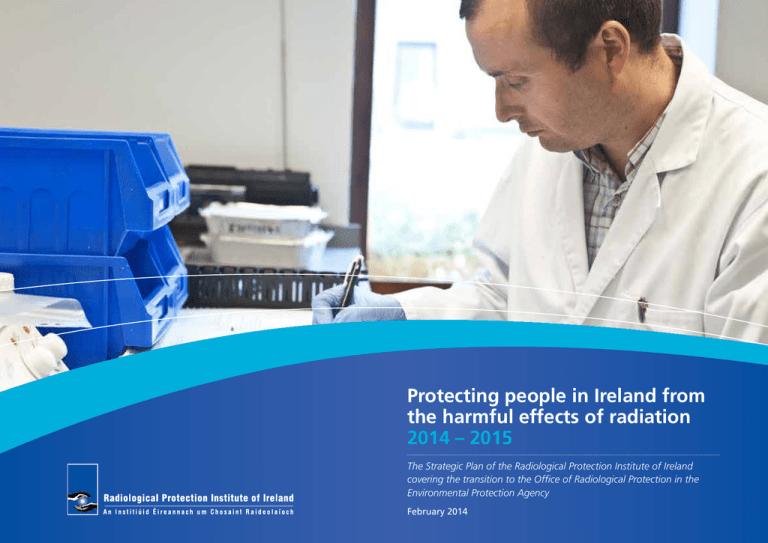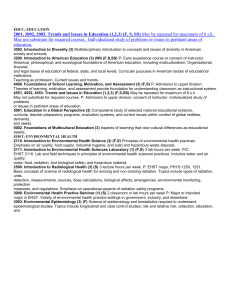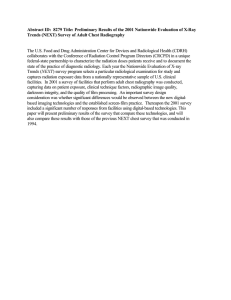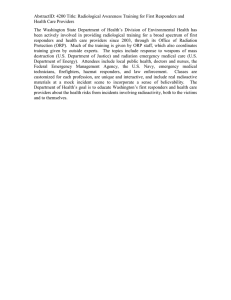Protecting people in Ireland from the harmful effects of
advertisement

Protecting people in Ireland from the harmful effects of radiation 2014 – 2015 The Strategic Plan of the Radiological Protection Institute of Ireland covering the transition to the Office of Radiological Protection in the Environmental Protection Agency February 2014 Exposure to ionising radiation Mankind is continuously exposed to ionising radiation from a range of natural and man-made sources. Sources of natural radiation include radon gas, cosmic radiation originating from outer space and long-lived radioactive substances present in the earth’s crust since the formation of the planet. Man-made radiation sources include X-rays used to diagnose diseases and for cancer therapy. They also include sources used in industry and research and the radioactivity present in the environment as a result of the routine operation of nuclear power plants and past nuclear accidents. The relative contribution of these different sources of exposure to the average radiation dose received by people living in Ireland is shown below. From this figure it is clear that the average dose is dominated by radiation from natural sources such as radon gas in homes and workplaces. Mission Vision To ensure that people in Ireland are protected from the harmful effects of ionising radiation. The public will have confidence and trust in the radiation protection infrastructure and be assured that the highest international standards are applied in Ireland. The uses of man-made sources of radiation in applications such as cancer treatment, diagnostic radiology and civil engineering provide significant benefits to society. However, if not properly controlled and managed they have the potential to result in high exposures to individuals. The goal of radiological protection, therefore, is to ensure that people and the environment are adequately protected from the harmful effects of ionising radiation, while allowing society to take advantage of the many beneficial applications. Merger of RPII with EPA In Ireland, the Radiological Protection Act, 1991 establishes the legal framework for radiological protection and assigns key responsibilities to the Radiological Protection Institute of Ireland (RPII). In November 2012, the Government announced a merger between the RPII and the Environmental Protection Agency (EPA). Work is underway to implement the merger by mid-2014 which will see the transfer of RPII’s functions and staff to the newly established Office of Radiological Protection in the EPA. In setting out the terms of reference for the merger “the need to ensure that there is no diminution, or perception of diminution among stakeholders and the general public, as regards Ireland’s commitment to either environmental or radiological protection, arising from the merger” was highlighted. Medical exposure of patients 13.7% Natural radioactivity in foods 6% Natural radioactivity in soils 7.6% Cosmic Radiation 8.7% Thoron 7.1% Artificial sources including Weapons, Chernobyl and Sellafield 0.4% Radon 56.5% Sources of exposure to ionising radiation for people living in Ireland Scope of this Strategic Plan This strategy has been written in the context of the merger and addresses the delivery of radiological protection during the period spanning the transition from RPII to the Office of Radiological Protection in the EPA. In order to avoid duplication with the merger process and recognising that the corporate structures are undergoing significant change, this strategic plan is focused on priorities for radiological protection and does not deal directly with corporate or support functions. It is recognised implicitly, however, that effective delivery on these priorities is dependent on the availability of well-functioning corporate supports, on-going investment in staff development and successful succession planning. Challenges and opportunities Radon Nuclear power Regulation Technology Organisation Ireland has one of the highest average indoor radon concentrations in Europe and it is estimated that exposure to radon accounts for approximately 13% or some 250 lung cancer cases each year. In early 2014, the Government approved a National Radon Control Strategy which sets out measures for public bodies working together aimed at reducing the risk from radon to people living in Ireland. UK energy policy dictates that new nuclear power stations should have a role in the country’s energy mix. In 2013, the UK Government gave the go-ahead for the first new nuclear station in a generation at Hinkley Point in Somerset, with another seven stations proposed to be built by 2025. The transposition of the recently agreed revised European directive governing radiological protection advocates a more “risk-based” approach to regulation. There is also a strong political desire to eliminate any unnecessary regulatory burden on business while ensuring that risks are adequately controlled. The internet continues to provide better and less expensive ways for citizens to interact with the State and allows public bodies to improve the range, quality, timeliness and accessibility of information available to the public. Developments in IT and technology generally continue to provide opportunities to improve process efficiency and quality. The merger with the EPA will bring challenges, but also opportunities. The tight timescale dictates that, initially, priority must be given to merging the corporate functions and maintaining delivery of the scientific and technical functions of both organisations. Over time, however, greater synergies and opportunities for cross-organisation working will be identified. THEMES 1 Ensure that ionising radiation is used safely in the workplace so that people are protected through... Strategic objectives Regulating the use of ionising radiation by means of authorisation, inspection,guidance and enforcement. Ensuring better outcomes and improved targeting of resources by implementing the new risk-based model for authorisation. Enhancing the sustainability of the regulatory system and making it easier for users to interact with the service by developing the new regulatory information management system. Reducing peoples’ exposure to radon by the successful implementation of the National Radon Control Strategy (NRCS). 2 3 Minimise the health and economic impact of natural and artificial radioactivity in the environment through... Sustain and enhance national capacity to deliver effective radiation protection through... Maintaining and developing RPII’s emergency response capability and continuing to contribute to national arrangements. Advising the public and decision makers on the implications of radiation in the environment and, where appropriate, on measures for protection. 4 Stakeholders will not see any diminution in the delivery of radiation protection in the transition to the Office of Radiological Protection (ORP) in the EPA. The NRCS implementation group is in place and reporting regularly to Government. The ORP is delivering actions in accordance with the timeframe set out in implementation plan. All preparatory work for IRRS mission (including: training, advance-meetings, self assessment, advanced reference material & action plan) is completed on schedule, arrangements for mission are put in place and an effective review is undertaken. Undertaking targeted monitoring and research to 1) assess the health implications of radioactivity present in the Irish environment and 2) to underpin confidence in the Irish environment and food chain. Stepwise implementation to the agreed initiatives aimed at enhancing the regulatory system (graded authorisation & regulatory information management system). Supporting the development of national policy and legislation. The ORP is providing effective and high quality radiation protection support to decision makers in developing national laws and policies and international standards and agreements. Contributing to the development of international policy and norms that enhance radiation protection and international nuclear safety for people living in Ireland. Ensuring that the right skills and expertise are available to deliver effective radiation protection. Strengthening and enhancing the effectiveness of the national regulatory infrastructure by hosting the IRRS international peer review. Building on and sustaining earlier progress in addressing radioactive waste in Ireland. Ensuring that all stakeholders can readily access the radiological services and information they need to support their own protection. Contribute to the achievement of a successful merged organisation through... Expected outcomes Delivering high standards of radiation protection through the Office of Radiological Protection in the EPA. Exploiting opportunities to increase public value for the merged organisation across all its activities. Proactively contributing to the seamless integration of all RPII staff and activities into the merged organisation. Proactively communicating and explaining to all stakeholders the impact of the merger for them. Delivering a high functioning efficient organisation both as RPII (pre-merger) and as ORP (post-merger). The merged organisation has developed clear targets aimed at integrating RPII activities into the organisation in a way which increases public value. These targets are being met. The public and stakeholders have timely access to high quality information on sources of ionising radiation with the potential to impact on people in Ireland. Furthermore, the information on radiation is readily available via the EPA’s website while the proportion of people accessing this information online is continuing to increase.



